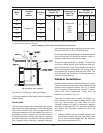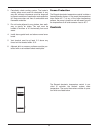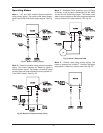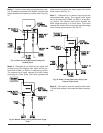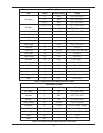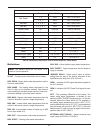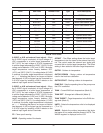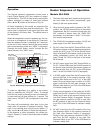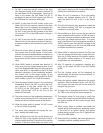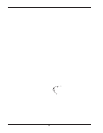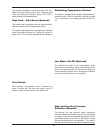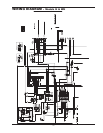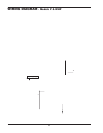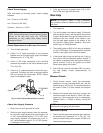
37
9. 24 VAC is sent from the NC contact of the High
Gas Pressure Switch to the common terminal of
the Low Water Cut Off (if equipped). Upon loss of
water in the heater, the Low Water Cut Off (if
equipped) will send a 24VAC signal to pin P3-4 of
the UDB board to indicate a safety fault.
10. 24VAC is sent from the NO contact of the Low
Water Cut Off to the common contact of the Auto
Reset High Limit (if equipped) and energizes the
coil of the alarm relay. If the Auto Hi Limit opens,
24 VAC is sent from the NO contacts of the Auto
Hi Limit to pin P3-3 of the UDB board to indicate a
safety fault.
11. 24 VAC is sent from the NC contacts of the Auto
Reset Hi Limit to the common terminal of the burn-
er switch located on the front exterior panel of the
heater.
12. When the burner switch is closed, 24VAC power
then travels from the NO contact of the burner
switch to the remote enable/disable connection at
terminal 11 of the rear j-box low voltage terminal
block and to the NO contact of the Enable/Disable
relay.
13. When 24VAC power is returned from terminal 12
of the rear j-box low voltage terminal block to the
coil of the Enable/Disable relay, the relay contacts
close, and 24VAC is transmitted to the Ht D (heat
demand) connection of the modulating tempera-
ture control and to the stage contact of the
modulating temperature control (pin#15 for P and
WHP models or pin#17 for H and WH models).
14. When the stage contact closes on the modulating
temperature control, 24 VAC is sent to the com-
mon terminal of the flow switch and to pin
P1-3(CFH) of the UDB board. In addition, the
amber “Call-for-Heat” LED on the front of the
heater will illuminate.
15. The pump contact on the modulating temperature
control closes sending 24 VAC to the pump switch
located on the front exterior panel of the heater.
16. When the pump switch is closed, 24 VAC is sent
to the coil of the pump relay.
17. The pump relay energizes and closes the con-
tacts, starting the heater pump.
18. Upon sufficient flow, the flow switch closes and
sends 24 VAC to the common terminal of the air
pressure switch and the TH terminal of the ignition
module. If the flow switch does not close, a 24
VAC signal is sent to pin P4-9 of the UDB board to
indicate an insufficient flow condition.
19. When 24 VAC is received at TH on the ignition
module, the contacts between pins F1 and F2
close and send 120 VAC to pin 1 of the blower
relay.
20. The coil of the blower relay energizes closing the
NO contacts sending 120 VAC to energize the
combustion air blower motor.
21. Once sufficient air flow is proven the air pressure
switch closes the NO contacts, 24 VAC is sent to
the heater interlock connection at terminal 9 of the
rear j-box low voltage terminal block. If air pres-
sure is insufficient or lost during heater operation a
24VAC signal is sent from the NC contacts of the
air pressure switch to pin P4-10 of the UDB board
to indicate insufficient air pressure.
22. When 24VAC is returned to terminal 10 of the rear
j-box low voltage terminal block, power then trav-
els to the P Switch terminal of the ignition module.
The ignition module employs a 15 second pre-
purge before the next sequence.
23. After 15 seconds of combustion chamber pre-
purge, pin S1 sends 120 VAC to the Hot Surface
Igniter.
24. The Hot Surface Igniter will be energized for
approximately 30 seconds and must exceed 3.1
amp draw during heat up.
25. Once the ignition module determines the proper
operation of the Hot Surface Igniter, a 24 VAC sig-
nal is output from the Valve pin on the module to
energize the gas valve.
26. The gas valve is energized and the blue “Burner
On” LED on the front of the heater energizes.
27. The remote sensor is now trying to rectify the
flame. If the flame is not rectified within 4 seconds,
the ignition module will shut down the gas valve
and lock out.
28. When burner flame is rectified, the heater will
operate based on the electronic operating control.
In the event of an ignition lockout, the ignition
module sends a signal to pin P4-12 (ignition lock-
out) of the UDB board.
29. When the CFH is satisfied, the heater will return to
a standby condition awaiting the next CFH.



